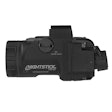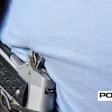A few years ago I had the opportunity to attend SIG Sauer's Academy and take the Defensive Rifle Course. While there I had the opportunity to shoot one of SIG's 550 series select fire assault rifles. I loved that weapon and I wanted one. Unfortunately, they were only available to military and law enforcement agencies, so my desire to own one went unfulfilled.
But the staff assured me that SIG Sauer was working on making the 550 family available to the public and to individual officers for purchase. The plan was for SIG's new rifle to be called the 556. It would use AR-15 magazines, keep the SIG 550 look, and, to make it available to the public, it would be semi-automatic. Best of all, it would retain the two-position gas adjustable gas piston, ensuring reliability under the worst of conditions.
When SIG started marketing the 556, it sold like there was a buy-one-get-one-free sale on the things. This meant editorial samples of the 556 were limited, and it was nearly a year after sales to the public started that one was available for test and evaluation. Ever since it arrived months ago for testing, I've been putting the 556 SWAT SIG through its paces. The rifle has been everything I hoped for.
Duty Ready
The 556 is a duty-ready rifle built to accept various optics, lights, other aiming devices, and vertical forearms; it even ships with SIG's Grip-Light.
Unlike other "black guns," which are gas operated, the 556 is piston driven. The piston system reduces the fouling of the bolt and the associated moving parts. The gas tube vents gas through the numerous ports before the piston drives the rotating bolt. This venting is what reduces dirt, and ultimately reduces cleaning time. Should the system get dirty, the two-position adjustable gas piston of the 556 ensures that it will run in the worst of conditions.
SIG uses a 16-inch cold hammer forged barrel with one-in-seven twist rate on the 556 to stabilize a wide variety of bullet weights. As an added bonus, the company makes its own barrels, so it can maintain quality control throughout the manufacturing process. Mated to the barrel is SIG's flash suppressor, which does a superior job reducing the flash signature of the 556. The flash suppressor has an ACME-type thread, so it will mate with select sound suppressors.
The barrel is threaded to a high carbon steel upper receiver, which is Nitron coated to ensure the receiver is corrosion resistant. This ensures a solid shooting platform capable of handling the hottest rounds while enhancing the accuracy of the rifle. To facilitate the installation of optics, the receiver is a "flat top" Picatinny rail with a built-in, hidden rear sight. This sight is not designed to be a primary sight; it is purely a backup in the event your optics go down.
The rifle's charging handle and bolt are contained in the upper receiver. There is no dust cover over the receiver; SIG opts to use a slotted rubber cover to keep out debris. It appears to me that the system works well. I say this because I haven't noticed any "stuff" in my receiver.
The upper receiver is mated to the lower using a rear push pin and slotted front pivot pin. There is no play between the receivers and the seam is flush and smooth.
As on many other black guns, the lower receiver of the 556 is CNC machined aluminum, which is hard coat anodized. The ambidextrous safety and magazine release are located on the lower receiver as they are on an AR-15. The bolt release is behind the magazine well above the trigger and is pushed down to lock the bolt up to release it.
A major design change for the 556 over other 550 series rifles is the magazine. The 550 used proprietary magazines, which are in limited supply. SIG redesigned the 556 to accept AR-15 magazines, giving operators a large and affordable supply of magazines. The mag well on the 556 is larger than ARs, assisting in smoother, faster reloads.
The forearm is a vented aluminum quad rail. Venting the front rail reduces heat build-up and reduces the weight of the 556.
To protect the Picatinny rails, SIG includes snap-on polymer rail covers. The railed forearm and receiver are level, allowing optics to mate with magnifiers and night vision devices.
SIG ships the SWAT 556 with its Grip-Light. This is a vertical grip with a removable high intensity LED STL 100 light. There is a trigger to activate the light, and it can be locked out so you won't inadvertently activate the light.
While the 556 doesn't use a buffer tube assembly common to ARs, it was designed to accept AR stocks. SIG installs a Magpul CTR on the 556. This is a five-position stock that can be locked in place, which reduces the chances of the stock accidentally collapsing and eliminates the wobble of adjustable stocks.
The 556 was finished in all black with SIG's Nitron finish or hard anodizing. Both finishes were smooth and even on all parts. The finish on the 556 will help ensure your carbine does not corrode and can be easily cleaned.
Adding Optics
Before I took the 556 to the range, I made a few changes. First, I removed the Grip-Light and installed a Wilcox Industries Steady Grip with bipod. I prefer this grip because it gives me a quickly deployable bipod and adds very little weight to the weapon. This bipod is very stable and is what I planned to shoot the 556 from when testing its accuracy.
I also wanted my 556 to have optics that could function for multiple missions. For this reason, I chose Leupold's Mark IV CQ/T. The CQ/T is a variable power scope with a magnification range of one to three power. This scope has a dot for fast acquisitions at close-quarter-battle distances and magnification when accuracy is required. The CQ/T also has an electronic amber dot for low-light applications. Best of all, the scope is powered by easy to find, inexpensive AA batteries.
To mount the CQ/T, I chose to use A.R.M.S. Inc.'s #12 mount. This mount lets me rapidly remove the CQ/T to use the backup sights or to install a more powerful telescopic sight should I need to make a more precise shot. The A.R.M.S. mount is rock solid and does not require you to confirm your sight's zero when you replace it.
Last, I contacted Magpul to acquire the rubber butt pad and cheek riser for the CTR Stock. The riser ensures proper eye-to-scope alignment and the rubber butt pad reduces the slipping of the stock during sustained firing.
Range Time
Once the 556 was equipped with optics and other accessories, it was time to take it to the range and see what it could do. I had a mixed bag of 5.56 ammunition that I used to zero the CQ/T because I didn't want to burn through premium ammunition getting the scope on paper. I know that many folks will disagree with this, but from past experience I have found if you get on paper with generic 5.56 ammo, you don't have to use as much good ammo to tweak zero.
Once I had the 556 zeroed, I loaded the magazines with 60-grain Hornady TAP FPD and Black Hills V-Max ammo. These loads have proven to be wicked accurate in my other 5.56 chambered rifles; I figured the 556 would follow suit.
I was not disappointed; the SIG shot both loads well. I fired 10-shot groups of both loads at 100 yards off the Wilcox Steady Grip/bipod.
The Hornady TAP FPD barely edged out the Black Hills V-Max by one-sixteenth of an inch. Both loads cloverleafed several rounds, but it was a balmy 12 degrees when I was shooting so my shivering may have pushed the group out to 1.25 inches. I am certain on a more climatically agreeable day I would have produced sub-MOA groups with the 556 with Hornady TAP and Black Hills V-Max 60 grain loads. This rifle is simply that accurate.
For grins I decided to try the 556 with 52-grain Black Hills Match Hollow Points, remanufactured. I did not adjust zero, simply sighted in and let fly. At 100 yards the 556 kept 10-round groups at less than two inches, about an inch high from point of aim.
Making It My Own
The 556 coupled with the Leupold Mark VI CQ/T is a versatile weapons system. I was so impressed with the 556 and the CQ/T that I have permanently added them to my vault. Planning to keep this rifle, I made a few additions. I attached a front clamp Sling Thing from GG&G with its quick detach sling loop and a Spec Ops Brand Mamba Sling, and I applied Lauer's Duracoat to it in ABU camo.
The Sling Thing is a rock solid mount for its pivoting sling swivel. When coupled with the sling swivel on the CRT and Spec Ops Brand's Mamba, the 556 lays flat on my chest, allowing access to my backup weapon, handcuffs, or anything else I need two hands for.
I coated the 556 and CQ/T with Dura Coat because I wanted my rifle to be unique, plus it makes the weapon easier to clean. Coating the rifle in a camouflage pattern also allows the rifle to blend into its environment; basic black stands out in a desert or brush setting. This finish also makes the weapon's system more corrosion resistant. For duty, being able to clean the weapon more easily and to protect it from the elements are both major pluses.
What is my opinion of the SIG 556? I purchased it; how much more can I approve of a firearm? This carbine is versatile, reliable, and simply dependable. The 556 can function as a patrol vehicle weapon or a SWAT weapon; with a telescopic sight it can function in the role of sniper and/or counter sniper rifle; and, if you get the urge, it can be used for competition. Simply put, the SIG Sauer 556 is a fine tool.
For More Information

















